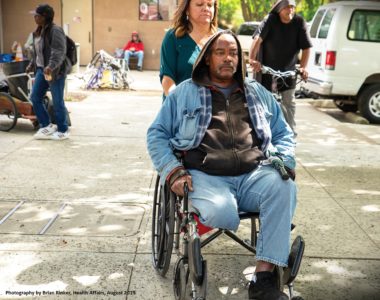Finding Shelter And Support Along The Road To Better Health

Photo by Brian Rinker
Driving along the north edge of downtown Sacramento, California, in a maroon minivan, community health worker Jamie Kaihe-Valles flipped on the turn signal and took a right onto a wide road that led to the homeless shelter where one of her clients was staying. Along the road, people had pitched tents and made camps by tying tarps and tattered blankets to a chain-link fence. There aren’t nearly enough shelter beds for the city’s growing homeless population, so the area surrounding this shelter has become a popular spot to hang out.
“There are a lot of campers out here,” Kaihe-Valles said, as she slowed the van to a stop for a man walking in the street who didn’t seem to notice her. “Hello,” she quietly said to herself, and then honked the horn—which got the man’s attention. “Sorry, don’t want to hit you, buddy,” she said, driving ahead.
Kaihe-Valles spotted her client, Noel Tyler—a fifty-three-year-old man who had had his right leg amputated last year—waiting for her in a wheelchair outside the shelter near a pile of various bike parts, as she pulled into a parking spot. Tyler, a solemn man with distant eyes and a graying horseshoe mustache, had landed at the shelter not long after he lost his leg. He had an appointment with a housing counselor that afternoon, and he was excited about the possibility of getting his own space with some actual privacy, rather than having to share with seventy-nine other men. Every day the shelter closed from 6 a.m. to 8 p.m., so Tyler, and everyone else staying there, had to leave for fourteen hours. Tyler often went to Loaves and Fishes, a nearby homeless services provider that offered food, coffee, showers, and a safe place to hole up for the morning. Then he’d head over to the public library and then back to the shelter, to wait outside until they opened the doors for dinner.
Read the full story by clicking here.
